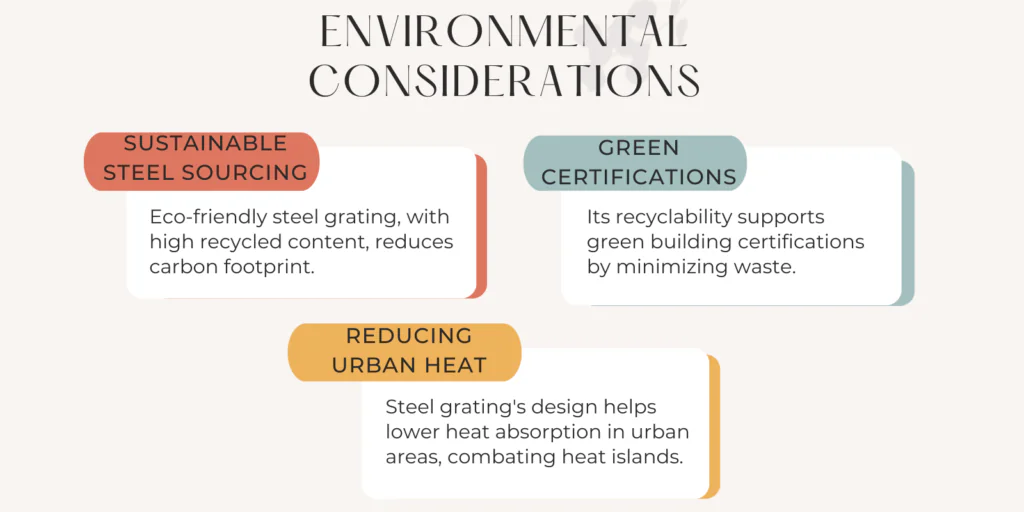Have you ever walked through a beautifully designed park or urban space and noticed the sleek, modern touch of steel grating? While landscape architecture often brings lush greenery and organic materials to mind, there’s a growing trend of integrating industrial elements for both form and function. With its unique blend of durability and aesthetic appeal, steel grating is emerging as a favorite among landscape architects.
Incorporating steel grating into landscape design offers a fresh, contemporary look while addressing practical needs like drainage and durability. This versatile material not only stands up to the challenges of outdoor environments but also adds a touch of modern sophistication to spaces. As we delve deeper into this topic, you’ll discover the myriad ways steel grating is enhancing landscape architecture and why it might just be the perfect addition to your next project. Dive in with us and explore the fusion of industrial charm and natural beauty.
The Aesthetic Appeal of Steel Grating

Modern and Industrial Look
In today’s world, where urban spaces often blend the lines between nature and man-made structures, steel grating stands out as a material that effortlessly complements contemporary designs. Its sleek, linear appearance provides a contrast to the organic forms of plants and water, creating a balance between the industrial and the natural.
This juxtaposition is particularly appealing in urban landscapes, where designers aim to bring a touch of nature into concrete jungles. The metallic sheen and geometric patterns of steel grating can transform a simple walkway or seating area into a modern art piece, making it a favorite for cutting-edge landscape designs.
Versatility in Design
Steel grating isn’t a one-size-fits-all solution. It comes in various patterns, sizes, and finishes, each offering a unique visual impact. From dense patterns that offer more surface coverage to open designs that allow for better visibility and drainage, the choices are vast. This versatility means that landscape architects have a wide palette to work with, ensuring that the grating integrates seamlessly with the overall design vision, whether it’s a minimalist Zen garden or a bustling urban park.
Functional Benefits in Landscape Architecture

Durability
One of the primary reasons landscape architects are drawn to steel grating is its impressive durability. Designed to withstand the rigors of outdoor environments, steel grating resists corrosion, wear, and tear. Whether it’s exposed to harsh sun, rain, or snow, it retains its structural integrity and appearance, making it a long-lasting solution for outdoor spaces.
Drainage
Beyond aesthetics, steel grating plays a pivotal role in water management. Its perforated design allows rainwater to drain away quickly, preventing the accumulation of puddles in walkways or seating areas. This is especially crucial in urban landscapes where efficient drainage systems are essential to prevent flooding and waterlogging.
Safety
Safety is paramount in public spaces, and steel grating contributes significantly in this aspect. Many steel gratings come with slip-resistant surfaces, ensuring that they provide a secure footing even when wet. This feature is invaluable in areas prone to rain or near water features, where the risk of slipping is higher.
Environmental Considerations

Sustainable Sourcing of Steel
As environmental concerns take center stage, the sustainable sourcing of materials has become a priority. Steel, being recyclable, often contains a significant percentage of recycled content. This means that by choosing steel grating, landscape architects are often opting for a material that has a reduced carbon footprint.
Recyclability and Green Building Certifications
Steel grating’s recyclability goes beyond its initial production. Once its life cycle in a landscape project ends, the material can be recycled and repurposed, ensuring minimal waste. This attribute plays a role in green building certifications, where sustainable materials can contribute to points or credits, pushing projects towards higher sustainability ratings.
Reducing Heat Islands
Urban areas often suffer from the “heat island” effect, where concrete and asphalt surfaces absorb and radiate heat, raising temperatures. Steel grating, with its open design, allows for better airflow and reduces the heat absorption compared to solid surfaces. By integrating steel grating in landscape designs, architects can contribute to cooler, more comfortable urban spaces.
Innovative Applications in Landscape Design
| Walkways and Bridges | Steel grating enhances elevated paths and bridges, offering aesthetics and functionality. It provides unique views and a sense of openness, connecting visitors to nature. |
| Water Features | Steel grating adds a modern touch to water features, blending industrial style with the natural flow of water. It ensures safety and efficient water circulation. |
| Planters and Green Spaces | Beyond flooring, steel grating is used in vertical green walls and as barriers around planters, supporting plant growth and contributing to environmental benefits. |
Walkways and Bridges
Steel grating has found its way into the design of elevated paths and bridges, offering both aesthetic and functional benefits. These structures not only provide connectivity within a landscape but also introduce a vantage point from which visitors can view their surroundings. The transparency of steel grating allows for a unique visual experience, where one can see below their feet, making spaces feel more open and connected to nature.
Water Features
Incorporating steel grating in water features can add a contemporary touch to traditional designs. Whether it’s a cascading waterfall over a grating or a fountain with steel elements, the combination of flowing water and the industrial charm of steel creates a captivating visual. Functionally, steel grating aids in water circulation and provides a safe walking surface, preventing slips in wet areas.
Planters and Green Spaces
Steel grating is not limited to flooring. It’s being innovatively used in vertical applications like green walls or as protective barriers around planters. The grating supports climbing plants, allowing them to weave through, creating living walls that are both beautiful and environmentally beneficial.
Challenges and Solutions

Maintenance Considerations
While steel grating is durable, it’s not entirely maintenance-free. Regular cleaning to remove debris and potential corrosive agents, especially in areas with high pollution or salt exposure, is essential to maintain its appearance and longevity.
Heat or Glare Issues
In sunny environments, steel can become hot or produce glare. Solutions include applying coatings that reflect UV rays or integrating shading elements in the design to reduce direct sunlight exposure.
Customization Challenges
Every landscape project is unique, and sometimes, standard steel grating options might not fit the bill. Fortunately, manufacturers today offer customization, allowing architects to specify the exact size, pattern, and finish they need for their designs.
Conclusion
The fusion of steel grating in landscape architecture signifies the industry’s evolution, where traditional materials meet modern innovation. As urban spaces continue to transform, the need for materials that offer both functionality and aesthetic appeal becomes paramount.
Steel grating, with its myriad benefits, stands poised to play a significant role in shaping the landscapes of tomorrow. For architects and designers, it offers an opportunity to reimagine spaces, blending the industrial with the natural, creating landscapes that resonate with the contemporary world.


